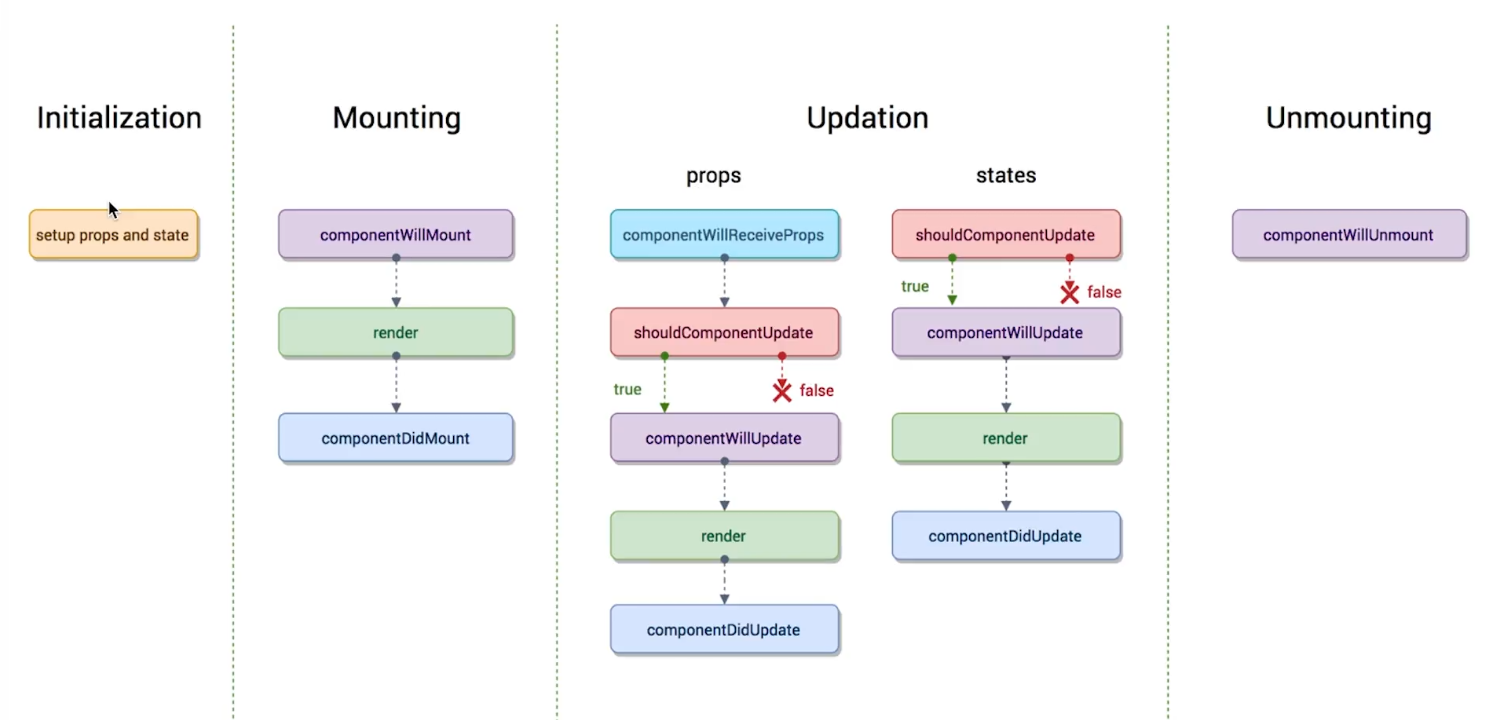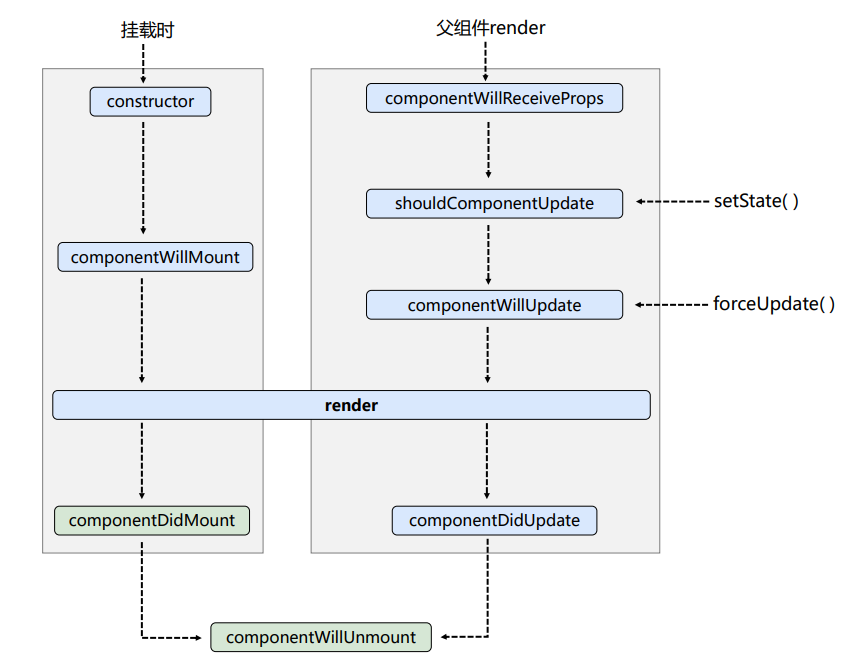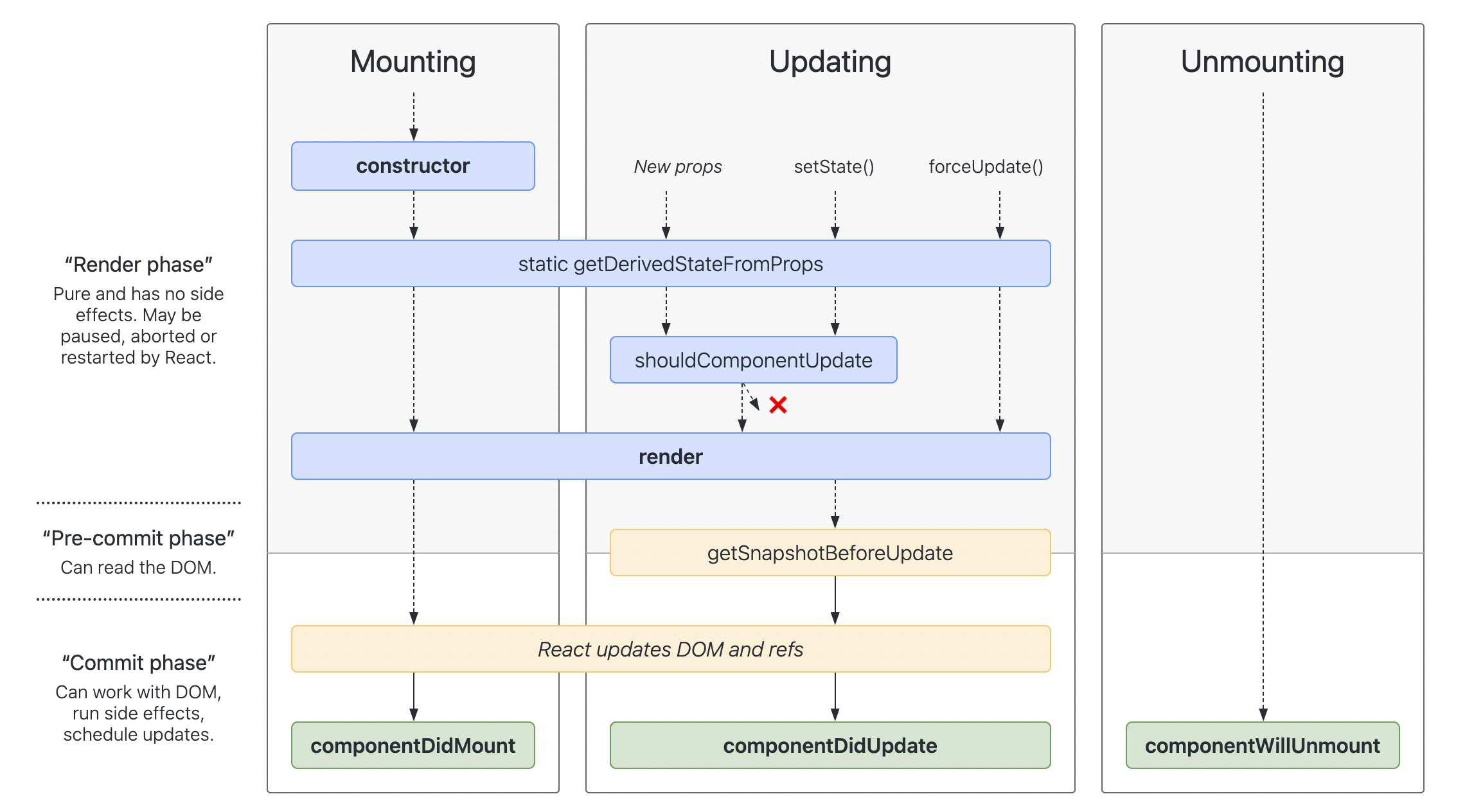组件从创建到销毁的一个过程,在这过程中,我们在每个特定阶段会触发一些方法。我们将这些方法称之为组件生命周期。组件生命周期主要可分为 初始化阶段、挂载阶段、更新阶段、卸载阶段。
自React V16.4发布以来,组件生命周期也产生了一些调整。本文会同时讲述两种生命周期的完整过程。
生命周期(旧)
如图所示,初始化阶段、挂载阶段、更新阶段、卸载阶段

//初始化生命周期constructor(props) { //构造函数super(props);this.state = {date: new Date()};}static propTypes = { //对类本身增加属性name:PropTypes.string.isRequired,},this.state = {date: new Date()}; //对类的实例对象增加属性//挂载阶段生命周期componentWillMount(){//组件将要被挂载}render(){return JSX} //返回虚拟DOMcomponentDidMount(){//组件挂在完毕调用 一般用来开启定时器 开启监听 发送网络请求}//更新阶段生命周期componentWillReceiveProps(nextProps){//只要接到了新的props,componentWillReceiveProps就会被调用,即便新props与旧的完全一样//父组件调用render 子组件的componentWillReceiveProps就会触发 不论props值是否变更//1.上级组件render或者props变化//2.组件第一次挂载 不执行componentWillReceiveProps//3.触发时 可以通过this.props访问preProps}--> this.setState({}); //setState函数执行之后调用shouldComponentUpdateshouldComponentUpdate(nextProps,nextState){return boolean; //返回布尔值来控制组件是否更新 是更新 否不更新}--> this.forceUpdate({}); //forceUpdate函数执行之后调用componentWillUpdatecomponentWillUpdate(nextProps,nextState){//组件是否将要更新}render(){return JSX}componentDidUpdate(preProps,preState){//组件更新完毕 通常记录当前props state与preProps preState的差异 来实现业务需求}//卸载阶段生命周期componentWillUnmount(){//组件将要卸载 一般用于清除定时器}
生命周期(新)
如图所示为React V16.4生命周期,初始化阶段、挂载阶段、更新阶段、卸载阶段。
//React V16.3将一些生命周期标记为UNSAFE_ 计划在未来的版本逐步移出这些生命周期//UNSAFE_componentWillReceiveProps(nextProps)//UNSAFE_componentWillMount()//UNSAFE_componentWillUpdate(nextProps, nextState)//初始化生命周期constructor(props) { //构造函数super(props);this.state = {date: new Date()};}static propTypes = { //对类本身增加属性name:PropTypes.string.isRequired,},//从props || state获取派生对象 不常用//由于16.4版本的修改 每次re-rendering都会调用该生命周期//1.父组件render 2.props change 3.this.setState() 4.this.forceUpdate()//getDerivedStateFromProps 用来取代 componentWillReceiveProps#1.react推出getDerivedStateFromProps生命周期的目的是为了代替componentWillReceiveProps#2.去实现基于props派生or更新state的诉求#特点#1.该方法是静态的,不能在函数内部使用this#2.该方法可以接收两个参数 来自父组件传递的props 组件自身的state#3.该方法需要返回一个对象(或者null)3.1react需要根据这个返回值去更新(派生) 组件的state3.2返回的对象会与该组件的state进行合并更新 不变更的时候return nullstatic getDerivedStateFromProps(props, state){if(props || state ){ 根据props||state 返回派生对象return {...state,xxx}}return null}this.state = {date: new Date()}; //对类的实例对象增加属性//挂载阶段生命周期render(){return JSX}componentDidMount(){//组件挂在完毕调用 一般用来开启定时器 开启监听 发送网络请求}//更新阶段生命周期--> this.setState({}); //setState函数执行之后调用shouldComponentUpdateshouldComponentUpdate(nextProps,nextState){return boolean; //返回布尔值来控制组件是否更新 是更新 否不更新}--> this.forceUpdate({}); //forceUpdate函数执行之后调用renderrender(){return JSX} //返回的是虚拟DOMgetSnapshotBeforeUpdate(prevProps, prevState){//在页面实际变化之前记录prevProps prevState并按业务需要返回快照对象(snapshot)//componentDidUpdate会接受到快照对象(snapshot)if(prevProps || prevState){return {...snapshot}}}componentDidUpdate(preProps,preState,snapshot){//组件更新完毕 通常记录当前props state与preProps preState的差异 来实现业务需求}//卸载阶段生命周期componentWillUnmount(){//组件将要卸载 一般用于清除定时器}
总结
新旧生命周期对比如下
- 新生命周期在计划移除componentWillReceiveProps、componentWillUpdate、componentWillMount
- 上面3个计划移除的生命周期,仍然可以使用但是会被标记UNSAFE_
- 新增了static getDerivedStateFromProps、getSnapshotBeforeUpdate
参考
- http://www.ayqy.net/blog/%E4%BB%8Ecomponentwillreceiveprops%E8%AF%B4%E8%B5%B7/
- https://segmentfault.com/a/1190000021827650 react生命周期详解
- https://www.jianshu.com/p/50fe3fb9f7c3 getDerivedStateFromProps详情解释
- https://projects.wojtekmaj.pl/react-lifecycle-methods-diagram/ react生命周期流程图
- https://www.icodebang.com/article/268804

